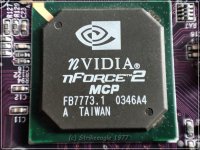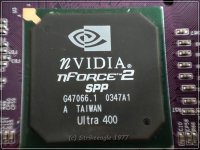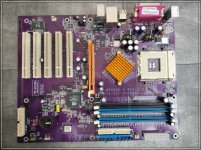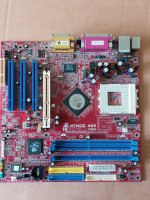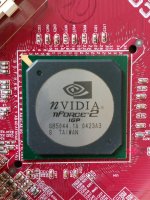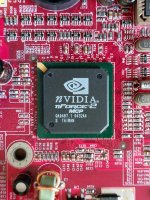so the assumption is that the hardcoded value for push/pull and open drain was the reason why AMD never allowed the release of the adapter back in the days?
Do all amd slot1 and 462 cpus support both modes or will using open drain lead to (for example) Bartons not working?
Well, that's what I'm thinking.

First it's important to understand how the SysPushPull parameter works. It's a 1-bit parameter in the ROMSIP that defines the state of the PushPull drivers. A value of 1 enables the PushPull drivers and puts the cpu in Push/Pull mode, a value of 0 leaves the PushPull drivers disabled and puts the CPU in Open-Drain mode. The ROMSIP itself is internally generated by the chipset on startup on these older chipsets and only partial configurable. Since the SysPushPull parameter is something that normally stays unchanged, it's value is hardcoded in the chipset. Either internally (AMD751 chipset) or via a strapping pin. (VIA KX133 chipset)
The status of this register wasn't that relevant in the earlier days of the Slot-A platform when both chipsets were released, the original Slot-A Athlons with external L2 chache don't have the PushPull drivers baked into their silicon and probably ignore the SysPushPull parameter altogether. The parameter became relevant with the release of the thunderbird core, which introduced the PushPull driver system. These drivers were implemented for the Socket-A platform to reduce motherboard costs (less components are needed) and to increase bus speeds. (the PushPull drivers can switch faster than the Open-Drain drivers, it's actually a very nice and sophisticated system)
The AMD751 chipset is hardcoded to SysPushPull=0 which is the recommended setting for Slot-A, this chipset probably wasn't meant to operate together with PushPull drivers. AMD never officially offered this chipset for their Socket-A platform. It is possible though, the Gigabyte 7IXE4 used this chipset in combination with Socket-A and PushPull drivers. Gigabyte had to add a seperate microcontroller to the motherboard to manipulate the ROMSIP such that SysPushPull is configured as 1 for enabling the drivers. They probably had a whole lot of AMD chipsets laying around that they had to get rid of in this manner.
VIA's approach was different. The KX133 chipset was released in early 2000, which was right between the release of the AMD751 chipset (June 1999) and the release of the newer Thunderbird Socket-A cpu's. (June 2000) Because of this, the chipset was designed for both Slot-A and Socket-A in order to prevent a short lifecycle. The KX133 chipset was a Slot-A optimized version of what would later become the KT133 chipset, proof for this can be found in the KX133 revision guide:
"
Removed “Socket-462” from description (chip is optimized for Slot-A) Updated VIA Logo to “Delivering Value” format"
The chipset was aimed at the newer Thunderbird cpu's that ran at higher bus speeds (133MHz instead of 100MHz) and used the PushPull driver interface. Thus the SysPushPull parameter is configured to 1 by default in this chipset. This value can be adjusted through a strapping pin by using a pull-up resistor on one of the adressing pins for the SD-RAM memory interface.
And now comes the part where shit hits the fan. A critical error was made on most of the KX133 boards; they didn't configure the state of the strapping pin for the SysPushPull parameter. (confirmed that on my Epox 7KXA board) With the introduction of the Thunderbird core, the SysPushPull parameter became relevant and a choice had to be made. Would the newer Slot-A cpu's keep using the open-drain interface for compatibility with the aging AMD chipset or would they switch to the PushPull interface for compatibility with the newer VIA chipset. AMD decided to keep using the Open-Drain interface on the Slot-A platform because all the AMD based boards that have been sold till that point were hardcoded for Open-Drain operation. They left VIA out in the cold here.

This was especially painful since they were going through a lot of trouble with Intel for making an AMD chipset. (These were the evil days of Intel)
Many VIA boards were trying to run the newer Athlons in PushPull mode which resulted in instability since the pull-up resistors for the Open-Drain interface were interfering with the PushPull drivers. These resistors couldn't be removed as they were integrated into the CPU cartridge. I found an old article that also points in this direction:
今回の黒歴史は、VIAが最初にリリースしたK7向けチップセット「Apollo KX133」だ。Slot AからSocket Aへの迅速な移行を促した立役者であるが、問題を放置したまま廃番扱いにされた悲しい末路を辿っている。

ascii.jp
As a result of this dumpster fire, AMD probably didn't allow the release of a Slotket adapter. They wanted to end the support for the Slot-A platform ASAP as a means of damage control for their relations with VIA.

This is probably also why the Thunderbird Slot-A cpu's were initially OEM only and made in small numbers.
I do ask myself if the Asus K7V-T was a revision of the K7V to run in open-drain mode. This post got wayyy longer than anticipated.





:strip_exif()/i/2005737996.jpeg?f=meta)
 The PCB's are ordered now with assembly for the SMD components. I already bought some New-Old-Stock Sockets a while ago so this should be everything that's needed for the prototypes.
The PCB's are ordered now with assembly for the SMD components. I already bought some New-Old-Stock Sockets a while ago so this should be everything that's needed for the prototypes.
 This was especially painful since they were going through a lot of trouble with Intel for making an AMD chipset. (These were the evil days of Intel)
This was especially painful since they were going through a lot of trouble with Intel for making an AMD chipset. (These were the evil days of Intel)
 This is probably also why the Thunderbird Slot-A cpu's were initially OEM only and made in small numbers.
This is probably also why the Thunderbird Slot-A cpu's were initially OEM only and made in small numbers.
 I also managed to find two more Slot A boards for testing:
I also managed to find two more Slot A boards for testing: